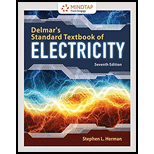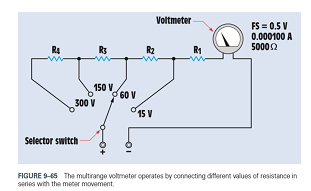
EBK MINDTAP FOR HERMAN'S DELMAR'S STAND
7th Edition
ISBN: 9781337900614
Author: Herman
Publisher: VST
expand_more
expand_more
format_list_bulleted
Concept explainers
Textbook Question
Chapter 9, Problem 2PP
The meter movement described in Question 1 is to be used to construct a multirange voltmeter. The meter is to have voltage ranges of 15 V. 60 V, 150 V, and 300 V (Figure 9-65). Find the values of

Expert Solution & Answer
Want to see the full answer?
Check out a sample textbook solution
Students have asked these similar questions
A
circuit is given as shown.
(a) Find and label the circuit nodes.
(6) Determine I, I₁, I2 and V₂
I₂
+1
I
12V
ww
22
2
ти
+
보통 162
-
ти
4
52
12
50
602
I
1
Mw
a) A silicon wafer is uniformly doped p-type with NA=10¹³/cm³. At T=0K, what are the equilibrium
hole and electron concentrations?
1016
1015
Ge
101
Si
1013
1012
GaAs
10"
(( uວ) uot¤ງແລ້ວuo ວາ.ຂ ວາsuuuT
0101
601
801
107
10%
Determine the equilibrium electron and hole concentrations inside a uniformly doped sample of Si
under the following conditions. (n; =1010/cm³ at 300K)
a) T 300 K, NA << ND, ND = 1015/cm³
b) T 300 K, NA = 9X1015/cm³, ND = 1016/cm³
c) T = 450 K, NA = 0, ND = 1014/cm³
d) T = 650 K, NA = 0, ND = 1014/cm³
10°
200
300
400
500
600
700
T(K)
Chapter 9 Solutions
EBK MINDTAP FOR HERMAN'S DELMAR'S STAND
Ch. 9 - To what is the turning force of a dArsonval meter...Ch. 9 - Prob. 2RQCh. 9 - A DC voltmeter has a resistance of 20,000 per...Ch. 9 - 4. What is the purpose of an ammeter shunt?
Ch. 9 - 5. Name two methods used to make a DC multirange...Ch. 9 - 6. How is an ammeter connected into a circuit?
Ch. 9 - 7. How is a voltmeter connected into a circuit?
Ch. 9 - 8. An ammeter shunt has a voltage drop of 50 mV...Ch. 9 - 9. What type of meter contains its own separate...Ch. 9 - 10. What electrical quantity does the oscilloscope...
Ch. 9 - 11. What is measured on the Y axis of an...Ch. 9 - 12. What is measured on the X axis of an...Ch. 9 - 13. A waveform shown on the display of an...Ch. 9 - 14. What is the major difference between a...Ch. 9 - 15. What two factors determine the turning force...Ch. 9 - You are an electrician on the job. You have been...Ch. 9 - 1. A d'Arsonval meter movement has a full-scale...Ch. 9 - 2. The meter movement described in Question 1 is...Ch. 9 - 3. A meter movement has a full-scale value of . A...Ch. 9 - 4. The meter movement in Question 3 is to be used...Ch. 9 - 5. A digital voltmeter indicates a voltage of 2.5...
Knowledge Booster
Learn more about
Need a deep-dive on the concept behind this application? Look no further. Learn more about this topic, electrical-engineering and related others by exploring similar questions and additional content below.Similar questions
- b) A semiconductor is doped with an impurity concentration N such that N >> n; and all the impurities are ionized. Also, n = N and p = n2/N. Is the impurity a donor or an acceptor? Explain.arrow_forwardd) For a silicon sample maintained at T=300K, the Fermi level is located 0.259 eV above the intrinsic Fermi level. What are the hole and electron concentrations?arrow_forwarde) In a nondegenerate germanium sample maintained under equilibrium conditions near room temperature, it is known that n=10¹³/cm³, n = 2p, and NA 0. Determine n and ND.arrow_forward
- Solve fo the voltage across the 1kohm resistor using superposition for the three following cases: only V1 present, only V2 present, and both V1 and V2 present.arrow_forwardSemiconductor A has a band gap of 1eV, while semiconductor B has a band gap of 2eV. What is the ration of the intrinsic carrier concentrations in the two materials (n₁A/NB) at 300 K. Assume any differences in the carrier effective masses may be neglected.arrow_forwardc) The electron concentration in a piece of Si maintained at 300K under equilibrium conditions is 105/cm³. What is the hole concentration?arrow_forward
- 5. Represent the following system in state-space form. Write A, B, C and D clearly in your answer. d³y d²y dt3 - +5y=2u dt²arrow_forward3. Find the transfer function H(s) and frequency response H (w) of the following system whose differential equation is given by d¹y d³y +3. dy +5 dt4 dt3 dt - d²u du 4y = - 5 dt² dtarrow_forward1. Consider a plant that you want to control. The input u(t) and output y(t) of the plant are related by y(t) = 7 u(t) + w(t) where w(t) is an additive disturbance at the output which is bounded by -0.5 w(t) ≤0.5 for all time t. You want to build a controller so that the output follows a constant reference signal r(t) = where -15 ≤≤ 15. You will consider both open-loop and closed-loop for this problem. a) Sketch the block diagram of the plant. b) Please build an open-loop controller that sets the output to 7, assuming the disturbance is ignored. Please show your controller both as an equation and a block diagram. c) Say that you use the open-loop controller in part b, but now the disturbance w(t) is present. What is the maximum possible magnitude of error in the output for the reference signal? Suppose you have designed a feedback control for the plant where the controller has the form u(t) = K(r(t) − y(t)). Here K is the gain constant of the controller that you will design. d) Please…arrow_forward
- 2. Suppose the Laplace transform of a causal signal x(t) is given by s² +2 X(s) = S³ + 1 Using the lookup tables for standard Laplace transforms and the Laplace transform properties, find the Laplace transforms of the following signals. You do not need to simplify the expressions. a) x₁(t) = e² x(t) + 38(t − 1) − (t − 2)² u(t − 2) b) x2(t) = x(2t - 1) + et u(t − 2)arrow_forwardPlease explain in detail the steps to solve this. Thank youarrow_forward6. Answer the following questions. Take help from ChatGPT to answer these questions (if you need). But write the answers briefly using your own words with no more than two sentences and make sure you check whether ChatGPT is giving you the appropriate answers in our context. a) What is the difference between a regulator and a servo system? Which is harder to build? b) What are the advantages and drawbacks of manual control systems over automatic ones? c) Does transfer exist for the non-linear systems? d) Explain the convolution property of the Laplace transform. e) What are the advantages of using state-space representation?arrow_forward
arrow_back_ios
SEE MORE QUESTIONS
arrow_forward_ios
Recommended textbooks for you
 Delmar's Standard Textbook Of ElectricityElectrical EngineeringISBN:9781337900348Author:Stephen L. HermanPublisher:Cengage Learning
Delmar's Standard Textbook Of ElectricityElectrical EngineeringISBN:9781337900348Author:Stephen L. HermanPublisher:Cengage Learning Electricity for Refrigeration, Heating, and Air C...Mechanical EngineeringISBN:9781337399128Author:Russell E. SmithPublisher:Cengage Learning
Electricity for Refrigeration, Heating, and Air C...Mechanical EngineeringISBN:9781337399128Author:Russell E. SmithPublisher:Cengage Learning

Delmar's Standard Textbook Of Electricity
Electrical Engineering
ISBN:9781337900348
Author:Stephen L. Herman
Publisher:Cengage Learning

Electricity for Refrigeration, Heating, and Air C...
Mechanical Engineering
ISBN:9781337399128
Author:Russell E. Smith
Publisher:Cengage Learning
Electrical Measuring Instruments - Testing Equipment Electrical - Types of Electrical Meters; Author: Learning Engineering;https://www.youtube.com/watch?v=gkeJzRrwe5k;License: Standard YouTube License, CC-BY
01 - Instantaneous Power in AC Circuit Analysis (Electrical Engineering); Author: Math and Science;https://www.youtube.com/watch?v=If25y4Nhvw4;License: Standard YouTube License, CC-BY